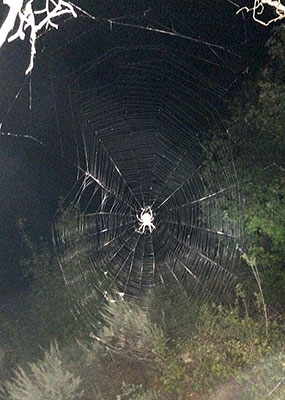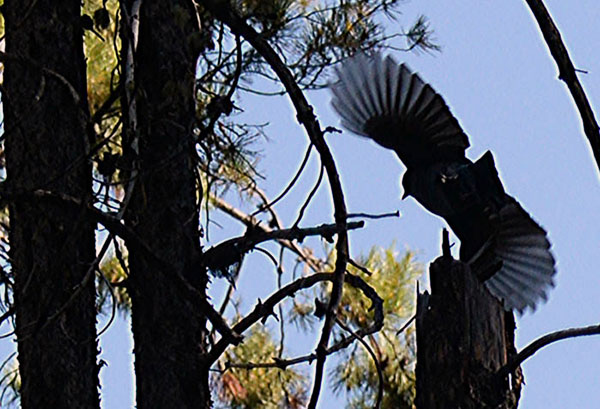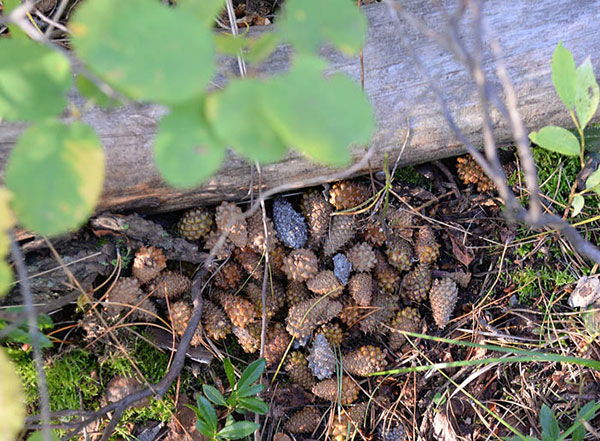LAST UPDATED: May 1st, 2015
My clumsy stumble through some gnarly sagebrush made me look up just in time in early September to avoid walking face-first into a basketball-sized spider web and its eight-legged weaver, which looked capable of straddling a 50-cent piece.
I had just crested the ridge above our elk camp after a 35-minute ascent in the pre-dawn darkness. As usual when wearing a headlamp, I was studying the ground several feet ahead to avoid tripping over roots, rocks and other mountainside obstacles. I was also huffing and puffing in the thin mountain air, and looking forward to a five-minute rest while switching from climbing mode to hunting mode as daylight arrived.
Then I tripped, caught myself and shuddered when spotting the spider centered in its web inches away, my light reflecting off the arachnid and the web’s silky filaments. Later, an Internet search suggested it was an “orb-weaver,” a spider of low risk to humans because it’s not toxic and seldom bites.
Orb-weaver spiders often spin webs across walking trails during the night to catch insects.
Still, an “expert” cautioned that if an orb-weaver crawls across your face or head, you’d risk having a heart attack, especially if “older than age 40.”
Consider me vulnerable. After all, a day earlier I’d felt less threatened when scaring off a young black bear by waving my arms and half-yelling, “Shoosh! Shoosh!” when it popped from thick brush 18 yards away, heading straight for me. The bear stopped, tilted up its nose, turned, looked back over its shoulder, and then crashed off through the forest when realizing I was a dreaded human.
It’s funny that I carry a pepper-based bear spray while bowhunting in Idaho, but get scared more regularly by waddling skunks and pre-dawn spiders. And for actual injuries, I constantly bang my shins, chafe my hide and bruise my backside when tripping over logs, rocks and fallen branches.
Then again, even though our group remains wary of danger when hunting the Rockies’ treacherous terrain, we spend far more effort searching for elk, and trying to identify birds, mammals and other critters foreign to our Wisconsin experiences.
One of our biggest challenges in recent years is getting a good photo of a Steller’s jay, a large, black-headed, dark-blue plumed cousin to the bluejay. If you think a bluejay’s language is crude and coarse, wait till you hear a Steller’s jay. It’s a harsh, hacking scold that makes you wonder how anyone can classify them as songbirds.
Steller’s jays seem to forever fly, flit and feed in shadows beneath the forest’s upper canopy. Not once have I photographed a Steller’s jay in full sunlight to highlights its blue-plumed body. I’ve followed them through my viewfinder as they hopped branch to branch eating lichens, alighted atop the spires of dead firs, and pumped their broad, rounded wings to make long, graceful swoops – almost always in the shade.
The Steller’s jay is a raucous, obnoxious-sounding bird that seems mislabeled as a “songbird.”
And for all the ornithologists’ claims of a “bold, inquisitive nature” that draws Steller’s jays to the forest floor “to investigate visitors and look for food,” I’ve yet to see one anywhere near my level. If you want inquisitive, you’ll find it in better supply among the mountain’s chickadees and gray jays, and even its red-shafted flickers. Heck, even hairy woodpeckers seem more bold and inquisitive than the Steller’s jay.
Meanwhile, if you want bold, sassy and often irritating, you’ll find it regularly in the Rockies’ abundant red squirrels. These little workaholics seemingly spend every minute of daylight cutting pine cones from high above, and then gathering and caching them one by one in nearby middens.
Whenever possible, red squirrels run the length of fallen tree trunks to reach the midden, with their prize pine cone clamped in their mouth like an oversized cigar butt. Although red-squirrel middens aren’t as common as dung piles left by elk, bears, moose and mule deer, we stumble across them regularly while bowhunting elk.
A red squirrel’s “midden” is a food cache consisting of conifer cones.
However, one thing we had never seen during our nearly 10 years of bowhunting in southeastern Idaho was a lizard called a Western skink. My friend Mark Endris of Hillsdale, Wisconsin, surprised us when scooping up a skink near the creek bed bordering our campsite. Until these 3- to 8-inch critters reach adulthood, they feature a distinctive bright blue tail. As they age, the blue tail fades to gray but never loses all of its blue coloration.
Much like the orb-weaver spider, the Western skink isn’t too concerned with humans and poses no threat. It eats flies, insects, crickets, beetles, grasshoppers, spiders and earthworms.
The skink’s presence reminded me that whether we’re hunting high, low or somewhere in between in Idaho, this unfamiliar land 1,000 miles west of Wisconsin never runs short of mysteries and surprises.
The Western skink is a medium-sized lizard whose blue tail eventually fades to gray during maturity.

 By
By 







